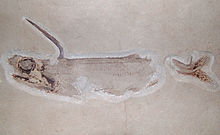| Falcatidae Temporal range:
| |
|---|---|

| |
| Falcatus specimen in Vienna | |
| Scientific classification | |
| Domain: | Eukaryota |
| Kingdom: | Animalia |
| Phylum: | Chordata |
| Class: | Chondrichthyes |
| Order: | †Symmoriiformes |
| Family: | †Falcatidae |
Falcatidae is a family of Paleozoic cartilaginous fish belonging to the order Symmoriiformes.[1] Members of this family include Falcatus, a small fish from the Bear Gulch Limestone of Montana.[2] The family first appeared around the start of the Carboniferous, and there is some evidence that they survived well into the early Cretaceous,[3] though its putative Cretaceous members were also argued to be more likely neoselachians.[4]
- ^ Coates, M.; Gess, R.; Finarelli, J.; Criswell, K.; Tietjen, K. (2016). "A symmoriiform chondrichthyan braincase and the origin of chimaeroid fishes". Nature. 541 (7636): 208–211. doi:10.1038/nature20806. PMID 28052054. S2CID 4455946.
- ^ Lund Richard (1985). "The morphology of Falcatus falcatus (St. John and Worthen), a Mississippian stethacanthid chondrichthyan from the Bear Gulch Limestone of Montana". Journal of Vertebrate Paleontology. 5 (1): 1–19. doi:10.1080/02724634.1985.10011842.
- ^ Guillaume Guinot; Sylvain Adnet; Lionel Cavin; Henri Cappetta (2013). "Cretaceous stem chondrichthyans survived the end-Permian mass extinction". Nature Communications. 4: Article number: 2669. doi:10.1038/ncomms3669. PMID 24169620.
- ^ Alexander O. Ivanov (2022). "New late Carboniferous chondrichthyans from the European Russia". Bulletin of Geosciences. 97 (2). doi:10.3140/bull.geosci.1845.